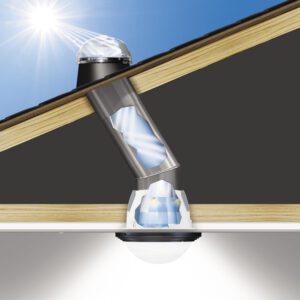What are Solar Tunnels
- Solar tunnels, also known as sun tunnels or tubular skylights, are designed to capture sunlight from the roof and channel it through a reflective tube into the interior of a building.
- This technology allows homeowners to enjoy the benefits of natural light without compromising energy efficiency.
How It Works:
- Rooftop Dome: The process begins with a rooftop dome that captures sunlight. This dome is strategically placed to maximize sunlight exposure throughout the day.
- Reflective Tube: Once captured, sunlight is directed through a highly reflective tube. The reflective surface ensures minimal light loss as it travels through the tube, even around bends or through obstructions.
- Diffuser: The tube then connects to a diffuser inside the home. The diffuser evenly distributes the captured sunlight, providing a natural and balanced illumination in the designated area.

Advantages of Solar Tunnels:
- Solar tunnels, also known as sun tunnels or tubular skylights, offer several advantages for homeowners seeking to enhance natural lighting in their living spaces.
- In summary, solar tunnels offer a holistic lighting solution that combines energy efficiency, cost savings, and positive impacts on well-being and aesthetics.
- Integrating these devices into your home can be a smart and sustainable choice for homeowners looking to enhance both their living spaces and their commitment to eco-friendly practices
- Here are some key benefits of incorporating solar tunnels into your home:
Energy Efficiency:
- One of the primary advantages of solar tunnels is their energy efficiency.
- By harnessing sunlight, these devices significantly reduce the need for artificial lighting during daylight hours.
- This can lead to lower electricity consumption and reduced energy bills, contributing to a more sustainable and cost-effective home.
Cost Savings:
- The reduced reliance on electric lighting translates to cost savings over time.
- Homeowners can enjoy the benefits of well-lit spaces without incurring the associated energy expenses.
Environmental Impact:
- Solar tunnels align with environmentally friendly practices by utilizing a renewable energy source—sunlight.
- By decreasing dependence on electric lighting, homeowners contribute to a reduction in overall energy consumption and the associated environmental impact, including lower greenhouse gas emissions.
Natural Light and Well-being:
- Natural light has been linked to various health benefits, including improved mood, increased productivity, and enhanced overall well-being.
- Solar tunnels allow homeowners to bring the warmth and brightness of natural sunlight into interior spaces, creating a more comfortable and uplifting living environment.
Versatility in Design:
- Solar tunnels provide a versatile solution for spaces where traditional windows or skylights may be impractical or impossible to install.
- They can be used in various architectural settings, including rooms without direct access to exterior walls or roofs.
Reduced Heat Gain:
- Unlike some traditional skylights, solar tunnels often incorporate design features to minimize heat gain.
- This allows the transmission of natural light without significantly increasing indoor temperatures, contributing to a more comfortable living space.
Daylight Harvesting:
- Solar tunnels offer a concept known as daylight harvesting, which involves maximizing the use of available natural light.
- This not only reduces the need for electric lighting during the day but also supports a more sustainable and energy-efficient approach to home design.
Enhanced Aesthetics:
- The introduction of natural light through solar tunnels can enhance the aesthetics of interior spaces.
- Well-lit rooms feel more spacious, inviting, and visually appealing, contributing to an overall positive atmosphere in the home.
Installation Flexibility:
- Solar tunnels can be installed in a variety of roofing types and configurations.
- Their flexibility makes them suitable for different architectural styles and allows homeowners to customize their lighting solutions based on their specific needs and preferences.
Minimal Environmental Impact:
- Solar tunnels have a relatively low environmental impact during both manufacturing and operation compared to some other lighting solutions.
- They do not require electricity to operate, reducing the overall carbon footprint associated with lighting.
Installation Guide
- Installing a solar tunnel for lighting in your home involves a careful process to ensure optimal performance and efficiency.
- Here is a step-by-step guide to help you with the installation:

Materials and Tools:
- Solar tunnel kit (includes rooftop dome, reflective tube, and diffuser)
- Measuring tape
- Roof flashing
- Roof sealant
- Saw
- Screwdriver
- Adjustable wrench
- Ladder
- Drywall saw or keyhole saw
- Ceiling frame or light fixture (if needed)

Choose the Installation Location
- Select a location on your roof that receives ample sunlight throughout the day.
- Consider potential obstructions, such as trees or other structures, that may cast shadows on the solar tunnel.
Measure and Mark
- Measure the diameter of the reflective tube and mark the corresponding hole size on the roof. Use the measuring tape to ensure accuracy.
Cut the Roof Opening
- Carefully cut the marked opening in your roof using a saw. Take precautions to avoid damage to the roof structure and to ensure a clean and precise cut.
Install Roof Flashing
Place the roof flashing around the opening to create a watertight seal. Secure the flashing in place using screws and an adjustable wrench.
Mount the Rooftop Dome
Install the rooftop dome over the opening and secure it in place according to the manufacturer’s instructions. Ensure a tight seal to prevent water leaks.

Connect the Reflective Tube
Attach the reflective tube to the rooftop dome. The tube should be directed toward the area where you want to bring in natural light. Some tubes may have adjustable elbows to accommodate different roof angles.
Secure the Tube Inside the Attic
Secure the reflective tube inside the attic space, making sure it is well-supported and straight. Use brackets or straps to fasten the tube to rafters or other structural elements.
Create an Opening in the Ceiling
Using a drywall saw or keyhole saw, create an opening in the ceiling where the diffuser will be installed. Follow the manufacturer’s instructions for the specific dimensions and placement of the opening.
Step 9: Install the Diffuser
Attach the diffuser to the end of the reflective tube inside the house. Secure it in place according to the provided instructions, ensuring a snug fit with the ceiling.
Step 10: Seal and Insulate
Apply roof sealant around the rooftop dome and flashing to prevent water leaks. Additionally, insulate the tube in the attic to minimize heat transfer.
Complete Interior Finishing
If necessary, complete any interior finishing work around the diffuser, such as installing a ceiling frame or integrating the solar tunnel with existing lighting fixtures.
Test and Adjust
Once the installation is complete, test the solar tunnel during daylight hours to ensure proper light transmission. Make any necessary adjustments to optimize the system’s performance.
Professional Assistance:
- If you are uncomfortable with any aspect of the installation process or if your roof design is complex, it is advisable to seek professional assistance.
- Professional installers can ensure that the solar tunnel is installed safely and effectively, taking into account your specific home and roof characteristics.
- By following these steps and the manufacturer’s guidelines, you can successfully install a solar tunnel for lighting in your home, bringing the benefits of natural light into your living spaces in an energy-efficient manner.
Installation
- Professional installation is crucial to ensure optimal performance.
- Consider consulting with a reputable installer to assess your home’s unique characteristics.
Location Matters:
- Placement of the solar tunnel is key. Consider the path of the sun and potential obstructions to maximize sunlight capture.
Maintenance:
Regular cleaning of the rooftop dome and tube will help maintain the system’s efficiency.
Disadvantages of Solar Tunnel Light
While solar tunnels offer several advantages, it’s important to consider potential disadvantages and challenges associated with their use. Here are some drawbacks to keep in mind:
Dependency on Sunlight:
- The primary limitation of solar tunnels is their dependence on sunlight. They are most effective during sunny days, providing less illumination on overcast or rainy days and no light during nighttime. This means that alternative lighting sources may still be necessary in certain conditions.
Initial Cost:
-
- The upfront cost of purchasing and installing a solar tunnel system can be relatively high. This includes the cost of materials, professional installation, and any additional structural modifications needed for the roof and ceiling. While there are potential long-term savings on energy bills, the initial investment may be a barrier for some homeowners.
Installation and Water Leakage Issues
-
- Installing a solar tunnel requires cutting through the roof and ceiling, which can be a complex and labor-intensive process. It may be challenging for homeowners who are not experienced with roofing and construction work. Professional installation is often recommended, adding to the overall cost.
- Aesthetic Impact:
- The appearance of a rooftop dome on the exterior of a home might not be visually appealing to some individuals. While manufacturers often design these domes to be unobtrusive, personal preferences regarding aesthetics can vary.
Limited Light in Rooms:
- Unlike traditional skylights with shades or blinds, solar tunnels generally lack a built-in mechanism for controlling the amount of light entering the room.
- This means that users have limited control over the intensity of natural light, which might be a drawback in certain situations.
- Variable Light Quality:
- The quality of natural light delivered through a solar tunnel can vary depending on factors such as the time of day, weather conditions, and the orientation of the sun. This variability might affect the consistency of lighting in the interior space.
Maintenance Requirements:
-
- While solar tunnels require minimal maintenance compared to some other lighting options, they still need periodic cleaning. Dust, dirt, and debris on the rooftop dome or reflective tube can reduce the system’s efficiency over time.
Limited Applicability:
-
- Solar tunnels may not be suitable for all types of spaces. Rooms without direct access to the roof, or those surrounded by tall structures that cast shadows, may not benefit fully from a solar tunnel installation.
Heat Transfer:
-
- Depending on the design and materials used, solar tunnels may transfer some heat into the interior space. While efforts are made to minimize this through insulation, it’s something to consider in regions with extreme temperatures.
- Technology Limitations:
- While advancements have been made, solar tunnel technology may not be as mature or as versatile as some other lighting solutions. Ongoing improvements in design and materials may address some of the current limitations.
Conclusion:
- Incorporating solar tunnels into your home not only reduces your environmental impact but also enhances your living space with the beauty of natural light.
- As we strive for sustainable living, these innovative solutions empower homeowners to make eco-conscious choices without sacrificing comfort and aesthetics.
- Embrace the sun’s radiant energy and transform your home into a well-lit haven that seamlessly blends the benefits of modern technology with the timeless beauty of natural light.
- Illuminate your living spaces responsibly with solar tunnels, and let the sun shine brightly in every corner of your home.
- Before deciding to install a solar tunnel, it’s essential to carefully weigh these disadvantages against the potential benefits, considering your specific needs, budget, and the characteristics of your home.
- Consulting with a professional installer can also provide valuable insights into whether a solar tunnel is the right choice for your particular situation
